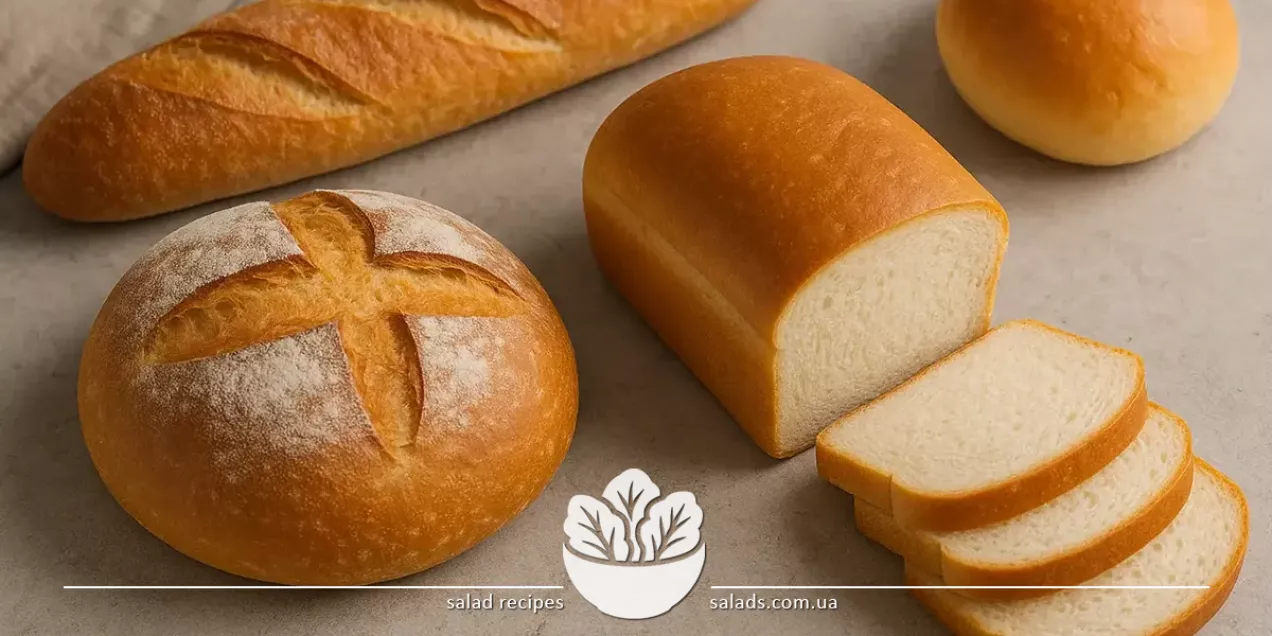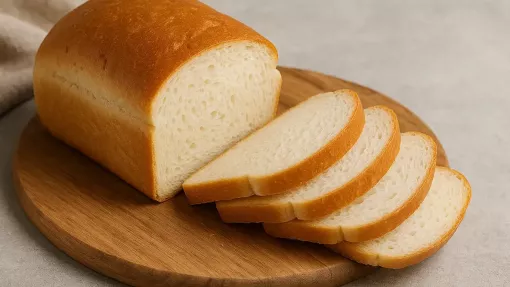Wheat Bread

Wheat bread is a dietary staple for millions of people around the world. It is made from wheat flour, which provides a soft texture and pleasant neutral taste. Among the bread category, the wheat variant remains the most versatile – it goes well with meat, vegetable, and sweet dishes. Depending on the type of flour and recipe, wheat bread may vary in color, density, and flavor.
Types of Wheat Bread
Main Varieties of Wheat Bread
Wheat bread comes in many forms and recipes, allowing for the perfect option for every taste and need. Classic white bread is made from refined flour, featuring a soft structure, light porosity, and a golden crust. It is great for sandwiches, toasts, and serving with soups. Whole wheat bread is made from coarse flour and contains more fiber, making it better for digestion. It has a richer flavor and denser texture. Some recipes include additional ingredients such as seeds, bran, kefir, or whey to add new taste dimensions and enhance nutritional value.
Popular variants include the French baguette, Italian ciabatta, and English sandwich bread. Each has unique structure, recipes, and traditional uses. For example, ciabatta is known for its large pores and soft crumb that easily absorbs sauces, while sandwich bread has the perfect shape for toasting. Wheat bread is often paired with natural additions such as herbs, which enhance aroma and make baked goods more expressive. Thanks to this, each type of wheat bread has its own identity and culinary role.
Nutritional Value and Health Benefits of Wheat Bread
Wheat bread has long been considered a dietary staple in many countries. It is an affordable source of energy due to its high content of complex carbohydrates, which provide lasting satiety and stable blood sugar levels. Especially beneficial are breads made from whole wheat flour, which retain the grain’s outer layers rich in dietary fiber, minerals, and vitamins. Whole wheat bread contains magnesium, iron, zinc, potassium, vitamins B1 (thiamine), B2 (riboflavin), B6 (pyridoxine), and folic acid, all of which support metabolism, the nervous system, and skin health. The fiber content helps promote digestion, stimulate the intestines, and eliminate toxins from the body.
Even regular white wheat bread can be a valuable part of the diet when consumed in moderation. Its easily digestible carbohydrates are especially useful for those with high energy needs – athletes, children, and manual laborers. To avoid excess stress on the body, it is best to choose breads without added sugar or artificial flavor enhancers. A healthy diet benefits from pairing bread with other nutrient-rich foods. For example, bread combined with mustard creates a balanced flavor profile, especially in sandwiches or snacks with meat and herbs. These combinations are not only delicious but also help the body absorb nutrients more efficiently.
Culinary Uses of Wheat Bread
Wheat bread is an incredibly versatile product, featured in breakfast dishes, snacks, main courses, and even desserts. In traditional cuisine, it is served with soups, borscht, salads, and meat or fish dishes. With its neutral flavor and soft texture, it’s ideal as a base for sandwiches, canapés, and toasts. In French cuisine, wheat bread is often used to make croutons and toast for salads, while in Italian cuisine, it’s used for bruschetta or panzanella. Wheat bread plays a special role in dish structure – it absorbs sauces, dressings, and juices from vegetables and meat well. It is frequently used as a base for stuffing or turned into breadcrumbs made from dried slices. In vegetarian cooking, it serves as a pizza crust alternative, flatbread substitute, or crunchy crouton component in salads.
Wheat bread is also used in pan-fried or baked dishes – for example, soaked in egg, sprinkled with spices, and baked with cheese or vegetables. In sweet recipes, wheat bread can be the base for puddings, crumbles, or simple baked desserts. Its soft texture pairs beautifully with fruits, honey, jam, and sugar. One of the more surprising yet harmonious combinations is bread with fruity elements like pineapple. You can add it to a sandwich or a salad with wheat croutons – such contrast creates a more complex and memorable taste. Thanks to its adaptability, wheat bread has become a true culinary tool in kitchens around the world.
How to Store Wheat Bread
To preserve the freshness and flavor of wheat bread, it’s important to store it properly. This product loses moisture quickly and can mold in high humidity, so temperature and packaging matter. The best method is storing it in tightly closed paper or cloth bags in a dry, dark place at room temperature. Plastic bags are not recommended for long-term storage – they trap condensation, which accelerates mold growth. Fresh wheat bread typically lasts 1-3 days before it begins to dry out. To extend its shelf life, slice and freeze it in portions. In this form, it keeps for up to a month – simply thaw for a few hours or toast straight from frozen.
Bread that has gone stale can be reused – for example, as breadcrumbs, croutons, or in baked dishes. Many recipes require dry bread to maintain shape, absorb aromas, and create crisp texture. It can also be grated and used as a base for homemade crumbles or oven-baked vegetable dishes. To enhance flavor and aroma during storage, you can add spices or flavorings, such as sugar in sweet dishes or vinegar in marinated sandwiches or sides. Careful storage practices reduce food waste and let you make the most of leftover bread.
Wheat Bread in a Balanced Diet
Despite common myths, wheat bread can be part of a healthy diet – if consumed in moderation and chosen wisely. The best options are breads with minimal sugar, no margarine, and added nutritious ingredients like bran, seeds, or whole grains. Such products contain more fiber, which promotes fullness and supports digestive health. Wheat bread is an excellent source of energy, particularly at breakfast or before physical activity. Thanks to its versatility, it’s easy to incorporate into a wide range of meals – from sandwiches to casseroles, salads, soups, and even desserts. It complements protein and vegetable components like herbs or sweet ones like pineapple, creating balanced meals with a complex flavor profile.
Nutritionists recommend including bread made from first- or second-grade flour, or whole wheat, in combination with healthy fats and proteins – such as legume spreads, vegetable pâtés, cheese, or baked meats. In this form, bread not only adds calories but also helps stabilize blood sugar and prevent overeating. It’s also worth paying attention to preparation methods: bread made with sourdough or minimal yeast is usually easier to digest and has higher nutritional value. Such bread keeps longer without preservatives and maintains its structure even after reheating. Wheat bread remains an essential part of food culture, and in today’s diet, its value is defined not only by ingredients but also by how it’s paired with diverse elements like vinegar, sugar, mustard, or peas. Smart consumption and thoughtful choices make bread a healthy, delicious, and balanced part of the daily diet.
